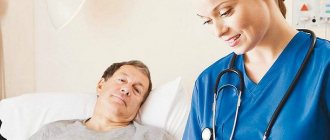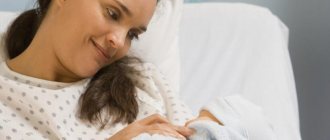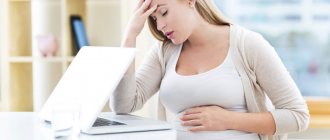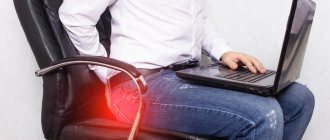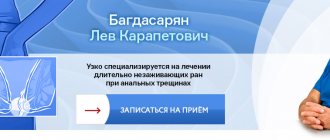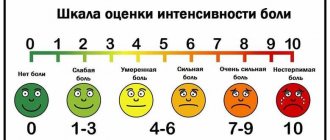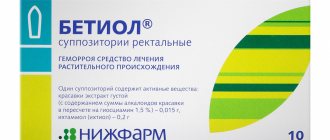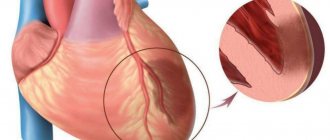Causes of hemorrhoids
Inflammation of the anorectal area after childbirth occurs not only as a result of excessive muscle tension and stretching of the hemorrhoidal veins during labor. In many ways, the development of postpartum hemorrhoids depends on the lifestyle of the pregnant woman. Factors that provoke rectal prolapse after childbirth include:
- Sedentary work, insufficient level of physical activity;
- Obesity, overweight;
- Poor nutrition;
- Family history (hereditary predisposition);
- Chronic constipation;
- Frequent stress.
How do hemorrhoids manifest after childbirth?
Usually the disease occurs in an acute form and is accompanied by the following pathological symptoms and disorders:
- Feeling of heaviness, burning, discomfort and itching in the anus;
- Painful sensations in the anorectal area during bowel movements. Gradually, the pain syndrome intensifies, and the patient begins to experience pain not only during bowel movements, but also when walking.
- The appearance of bleeding during or after bowel movements. The blood may be scarlet or dark in color. Blood clots may appear. Sufficiently heavy and constant bleeding can cause anemia, which negatively affects the patient’s health.
- Enlargement and prolapse of hemorrhoids. Initially, prolapse occurs directly during straining and defecation. In this case, as the pressure decreases, the nodes self-reduce. As hemorrhoids progress, prolapse of the nodes may occur during normal activities (lifting weights, sneezing, etc.).
- The formation of cracks in the anus, which provoke the development of inflammatory processes.
The chronic course of hemorrhoids can lead to strangulation, thrombosis and bleeding of the veins of the hemorrhoids, paraproctitis (infectious inflammation of the rectal tissue) and other complications. To avoid this, when you notice the first signs of hemorrhoids, you must consult a doctor who will prescribe appropriate treatment.
Surgery and minimally invasive procedures
In the third and fourth stages of hemorrhoids, surgery and minimally invasive procedures are used, since medications are ineffective. When breastfeeding, gentle procedures are carried out that relieve the woman of hemorrhoids and at the same time do not harm the baby.
One of the most popular treatment methods is called cryotherapy. Hemorrhoidal neoplasms are treated with liquid nitrogen. Necrosis of soft tissue occurs under the influence of low temperatures. After a few days, the tumors disappear.
An effective way to treat pathology is latex ligation using rings. During the procedure, a surgical instrument, a ligator, is used. A latex ring is placed at the base of the hemorrhoid. Blood does not enter the node, necrosis occurs, the node dies and disappears.
The procedures are carried out in the private proctology center “Proctologist 81”.
Features of traditional treatment of inflammation of the anorectal area after childbirth
The tactics and treatment regimen for hemorrhoids in women who have given birth differ from treatment in other people. Depending on the needs of the body, the shape and stage of hemorrhoids, as well as the severity of clinical manifestations, treatment of rectal prolapse after childbirth can be carried out using the following methods:
- Physiotherapy. Postpartum hemorrhoids are treated with a set of special exercises that help strengthen muscle tissue. Moderate exercise and walking outside during pregnancy will help prevent hemorrhoids after childbirth.
- Proper nutrition. Following a special diet will ensure the necessary metabolism and restore normal bowel movements. It is necessary to include foods enriched with fiber in your diet. Since constipation can make hemorrhoids worse, normalizing the frequency of bowel movements is very important.
- Treatment using medications (tablets, suppositories, creams, ointments). Their action is aimed at restoring tissue structures and relieving pain.
- Surgical treatment of inflammation of the anorectal region (excision of external hemorrhoids, sclerosis of internal nodes).
Also, women who have given birth and suffer from postpartum hemorrhoids should avoid wearing tight underwear and clothing.
Drug therapy
In the initial stages of hemorrhoids, women are prescribed Troxevasin in tablet form. The drug does not have a negative effect on the baby’s health; the components of the drug practically do not pass into breast milk.
During the lactation period, homeopathic medicines are also prescribed for the treatment of proctological diseases. Hemorrhoids are treated with venotonic drugs. Among them are Venza, Venoruton and others. If bleeding from the anus is profuse, then Ascorutin, which contains vitamin C, is effective.
To normalize intestinal function and improve microflora, you should take laxatives. This group of medications softens stool and prevents stool from stagnating in the intestines. Defecation will not be so painful, the hemorrhage will disappear.
Diet for hemorrhoids
Women diagnosed with postpartum hemorrhoids should exclude smoked foods, spices, flour and sweet products, as well as peppery and fatty foods from their diet during therapy. White bread should be replaced with other types of bread.
After hemorrhoids are cured, it is important to maintain a balanced and nutritious diet. In this case, you need to eat foods that improve digestion and enhance intestinal motility (fermented milk porridge, dishes rich in plant fiber, buckwheat and rice cereals, vegetable oils). This will ensure regular bowel movements.
The peculiarity of dietary nutrition for postpartum hemorrhoids is that the quality of breast milk should not deteriorate. Therefore, nursing mothers are recommended to eat apples, bananas, dried fruits and other fruits rich in saturated microelements and fiber. You also need fish and lean meat.
You should also control the amount of fluid consumed (at least 1.5 liters per day). It is recommended to abstain from tonic and carbonated drinks.
Physical exercise
One of the effective and affordable methods for preventing constipation in a nursing mother is light physical activity. Regular exercise will help strengthen the abdominal and perineal muscles. As a result, muscle tone increases, which helps to activate intestinal motility. Yoga, walking, swimming, and Pilates are suitable exercises for nursing mothers.
Also, don't ignore your daily warm-up. It is best to do exercises on an empty stomach. You should start with simple exercises, gradually increasing complexity. There are also specific exercises that increase intestinal contractility and help cope with constipation, for example:
- Stand straight with your feet shoulder-width apart.
- Take a deep breath, then strongly draw in and then sharply push out your stomach.
- Repeat the action 10 times and take a break.
Exercises must be performed at a slow pace, without sudden jerks. The main thing is regularity. As you get stronger, you can increase the number of repetitions. Gymnastics will help normalize bowel movements and improve your well-being.
Exercises while lying on your back
- Take a breath, stick out your stomach. As you exhale, draw in your stomach and lightly press your hands on the abdominal wall.
- Place your hands behind your head and stretch. At the same time, pull in your stomach. As you exhale, lower your arms and place them along your body.
- Lying on your back, bend your knees without lifting your heels off the floor.
- Pull your right knee towards your stomach as you exhale. Lower your leg while inhaling. Repeat the same with your left leg.
The “bicycle” and “scissors” exercises are good for constipation.
Exercises while lying on your stomach
- Place your hands under your shoulders. Get on all fours, without taking your hands off the floor, and then roll onto your feet. Take the starting position.
- Perform alternating leg swings with simultaneous retraction of the abdomen as you exhale and retraction as you inhale.
Hemorrhoids after childbirth: basics and specifics of osteopathic treatment
During breastfeeding, most surgical and conservative methods designed to treat hemorrhoids are contraindicated.
The most effective treatment in such a situation is osteopathy. To combat hemorrhoids, an osteopath uses special manual techniques to redistribute the load on the organs and normalize blood flow. Thanks to this effect, osteopathy fights the very cause of hemorrhoids, and not its clinical manifestations.
Osteopathy is an absolutely safe method that allows you to cure hemorrhoids without side effects. It is also advisable to use this method of manual intervention during pregnancy in order to prevent inflammatory processes in the anorectal area after childbirth. The duration of the course of osteopathic therapy is selected by the doctor individually, taking into account the severity of the pathological condition and the patient’s health status.
Osteopathic methods of combating postpartum hemorrhoids
To achieve maximum and lasting results, treatment of rectal prolapse after childbirth is carried out using visceral and structural osteopathy methods. The osteopath pays special attention to the condition of the spine, pelvic bones and coccyx. Slight displacement of the vertebrae can cause pinching of the spinal nerves. This leads to intestinal atony and impaired frequency of bowel movements, which in turn provokes the formation of hemorrhoids, the appearance of congestion in the pelvis and increased pressure in the hemorrhoidal veins. This is why osteopathic work with the spine and bones is so important in the fight against hemorrhoids.
When eliminating congestive processes, an important role is played by diagnosing the pelvic muscles and relieving their spasms, improving lymph flow and blood circulation, restoring the elasticity of the ligaments, as well as working with internal organs.
The effect of manual intervention is noticeable after several sessions. Hemorrhoids stop developing, alarming symptoms disappear, the nodes become smaller and stop bothering the patient.
Constipation symptoms
Constipation during breastfeeding can be accompanied by a number of symptoms. Even daily bowel movement, in which there is insufficient volume and dense consistency of stool, is considered constipation. Especially in cases where the condition is accompanied by abdominal pain, bloating, a feeling of heaviness, and a general deterioration in well-being.
Very often, constipation is combined with proctological diseases, if we talk about the postpartum period. Therefore, blood appears in the stool, associated with an anal fissure or exacerbation of hemorrhoids. This should be alarming. It is important to consult a doctor in a timely manner to receive qualified assistance.
Constipation leads to intoxication of the body, which can be manifested by the following symptoms:
- general malaise, fatigue;
- sleep disorders;
- decreased appetite;
- nausea;
- vomit;
- increased sweating;
- dizziness;
- headache.
In some cases, there is a slight increase in body temperature. Abdominal pain can occur in different parts of the abdomen: in the lower abdomen, in the right or left side, and even in the epigastric region. In cases where there is prolonged constipation, general health deteriorates greatly. Stool retention often leads to a longer recovery after natural childbirth and interferes with the healing of sutures after a cesarean section or episiotomy.
Constipation during breastfeeding in a mother often leads to sleep disturbances, increased irritability and other changes in the psycho-emotional sphere. And the general vulnerability of women in this difficult period obliges us to pay special attention to such a delicate problem.
Prevention of postpartum hemorrhoids
In order to prevent recurrent bowel prolapse after childbirth, generally accepted hygiene rules should be followed. After defecation, it is better to use soft toilet paper. If possible, wash with warm water after each bowel movement. You should also follow a proper diet to prevent constipation.
Effective means of preventing the disease include physical therapy exercises. Performing safe and simple physical exercises will help speed up the restoration of vascular tone in the pelvic organs and reduce the time of treatment for postpartum hemorrhoids.
Diagnostics
The diagnosis is made by a coloproctologist. If necessary, your doctor may refer you to other specialists for consultation. For the most successful treatment, seek medical help at the first symptoms. This will also help eliminate the risk of developing other diseases with similar symptoms.
Postpartum hemorrhoids are identified based on:
- patient complaints;
- inspection;
- finger examination;
- laboratory methods: blood test, urine test;
- instrumental diagnostics: sigmoidoscopy, irrigoscopy, colonoscopy, anoscopy.

